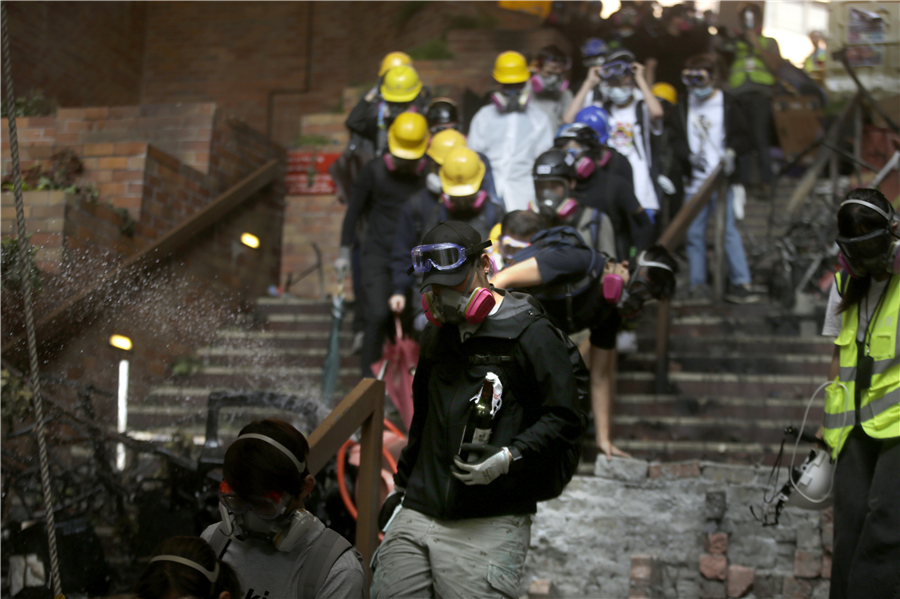Maintaining justice: Punishing rioters and compensating victims
By Grenville Cross | China Daily Asia | Updated: 2019-12-02 13:51

Although sentencing is an art and not a science, there are occasions when the duty of the courts is crystal clear. Public disorder is an obvious example of the type of criminality which invariably requires a firm response. As the Court of Final Appeal explained in its judgment in an unlawful assembly appeal in 2018, “public order must be maintained”, and this requires the judges “to consider the factor of deterrence in sentencing” (FACC 8/2017).
Although there will often be scope for leniency in sentencing, as when offenders are youthful or have acted out of character, there are limits. Grave crimes require condign punishment, and offenders who beg the courts for a chance may well be told that they should have thought about the consequences before committing the offence, not after. Judges, of course, always try to be merciful where possible, but there are times when severe penalties are in the public interest.
The “Hong Kong Indigenous” frontman, Edward Leung Tin-kei, for example, found this out to his cost last year, when he was sentenced to six years’ imprisonment for his role in the Mong Kok riot of 2016. Last week, Amy Pat Wai-fan, who helped protesters to dig up bricks and created fires in the same riot, was imprisoned for 46 months. The judge told Pat that her political beliefs did not justify harming residents’ livelihoods, or asking for leniency later on (DCCC 570/2018).
Although Pat has finally faced justice, it is a real concern that almost three years and 10 months have elapsed between the dates of offence and sentence. The secretary for justice, together with the judiciary, must do everything possible to ensure that this year’s riot cases are not also delayed. If, therefore, she has insufficient prosecutors, given that there have been almost 5,800 protest-related arrests, her department may have to brief some senior barristers to handle the cases. The judiciary, moreover, may need to appoint additional temporary judges and magistrates, always remembering that riot is one of the very rare offences in respect of which, under the Public Order Ordinance (section 19), magistrates are authorized to impose sentences of five years’ imprisonment, instead of their customary ceiling of two years’ imprisonment.
One protester, however, who has already received his comeuppance, is Ng Tin-pong. He joined over 1,000 protesters in besieging the police headquarters in Wan Chai on June 26, and has become the first offender to be convicted of unlawful assembly arising out of the disturbances. He also spray-painted a glass window at the entrance, and spat in the face of a senior police officer who told him to desist. Having pleaded guilty to assaulting a police officer, unlawful assembly, and criminal damage, Ng was sentenced to 10 months’ imprisonment, having been given the customary one-third discount for acknowledging his guilt. Although the sentence appears remarkably low, given the multiplicity of offences and the Court of Final Appeal’s sentencing guidance, and may yet be reviewed, the magistrate nonetheless condemned activities which amounted to “a direct attack on the rule of law” (ESCC 1903/2019).
However, as some of the protest-related cases are starting to come to trial, the judges and magistrates will now assume center stage. Their role will be pivotal, not only in trying the defendants, but also in ensuring that those who are convicted receive sentences which adequately punish them for what, in many cases, will be heinous crimes. After all, it is necessary not only to punish the actual offenders, but also to deter others. In this exercise, various considerations will play their part, including the need to hold offenders fully to account, as well as the promotion of public safety.
As earlier sentences have clearly not deterred riotous behavior, the judges will be fully justified in imposing far tougher punishments than previously. After all, it is only through the sentences they impose that the judges can demonstrate their abhorrence of particular conduct, and provide the police with the support they need in upholding law and order.
Many of the cases, moreover, will fall into the “worst category” of their type, which means that judges will be entitled to impose sentences at the top of the sentencing range, or at least close to it. With riot, for example, the maximum sentence is 10 years’ imprisonment, and it is hard to imagine graver instances of riotous behavior than have recently occurred. Through their sentences, the judges must try to protect society from future rioting, always remembering that weak sentences actually encourage further lawlessness.
The protest movement, moreover, has mounted a concerted campaign to smear dedicated police officers. This casts light on why, as of Nov 27, 1,261 complaints had been lodged with the Complaints Against Police Office, all related to protest activity since June 9. Most of these complaints are apparently designed to distract hardworking police officers when they are fully committed elsewhere, thereby weakening the policing of protests. As many of these complaints will be no more than cynical attempts to destroy the professional careers of dedicated officers, the courts must respond appropriately, and severely punish anyone convicted of making false reports and attempting to pervert the course of public justice.
The courts must, moreover, given the vast damage caused by the rioters, as well as the injuries to police officers and civilians, make full use of their powers to order offenders to pay compensation to their victims. The damage caused to the Legislative Council on July 1, for example, required over HK$40 million (US$5 million) to repair, while the bills for restoring the MTR will be massive. Those responsible for the wanton destruction must be made to pay, on top of their other punishments. It is certainly not right to expect taxpayers, businesses and insurance companies to foot the bill, and every last cent must be squeezed out of the culprits.
By their sentences, it is incumbent upon the courts to demonstrate that violent conduct is intolerable in a civilized society, and that rioters and their associates cannot defy the rule of law with impunity.
The author is a senior counsel, law professor and criminal justice analyst, and was previously the director of public prosecutions of Hong Kong.























